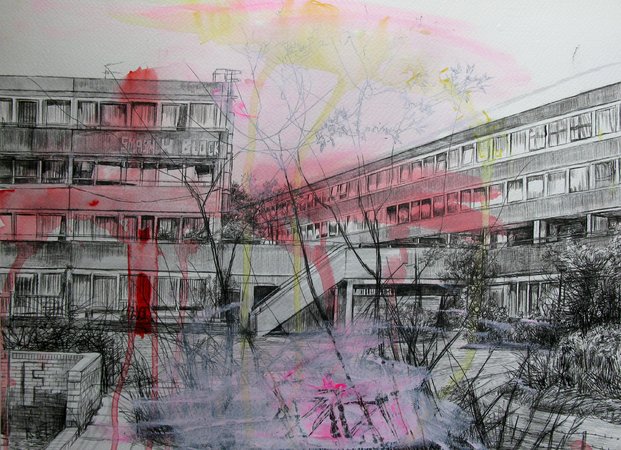
There seems to be a lot of exhibitions about the city on at the moment. Last weekend I purposely made my way across London to visit two. First was Paul Caton's An Internal Bleeding of the Heart at The Bearspace Gallery, Deptford. Caton's pencil drawings tell surreal stories that are both quaint and sinister: "Two hoodies wait in a ruined abbey. One, holding a large medieval sword keeps watch while the other sleeps. The blade glistens against the backdrop of dark trees and stone." .
These troubling, and yet also humerous myths set two protagonist hoodies against various idyllic countryside scenes. At first they seem to be transported straight from the urban environment into a romantic landscape, out of place and alienated. This is exactly the point Caton's making, he says "Their styling is just a post modern device to show that I mean what I'm talking about. This is a serious subject. If I have to rip-off Dutch masters to make a point then that's okay. The most important issue today is what is happening to the children. Art so far has ignored it. It isn't interested. It is too occupied by its own self."
Heading north, I then went to see Laura Oldfield Ford's London 2013, Drifting Through Ruins at Hales Gallery in the T Building. The exhibition consisted of a striking grid of over a hundred ink drawings that were distinct but also connected. Walking from one side of the room to the other, the viewer is taken through post industrial wastelands, weaving into living rooms and council estates. Oldfield Ford is as much an activist as an artist and also produces the zine Savage Messiah, documenting her psychogeographic "drifts" through London.

Compared to Caton, Oldfield Ford's drawings are more energetic and less fathomable. This layered style of drawing often seems to come out of a practice of psychogeography, a bit of a tired term for a way of exploring urban environments that has been around in various guises since the nineteenth century. It generally involves bringing together the physical landscape and something more subjective as a way experiencing the city and can often express an element of dissatisfaction and a desire for change.

Set in 2013, Laura Oldfield Ford's drawings are nothing like the shiny, optimistic architectural renderings of the Olympic sites, but instead form a sense of foreboding about the regeneration to come - the "failed utopias".
I found these two exhibitions interesting to see side by side. Paul Caton's drawings aren't the result of an urban drift, but they are an intriguing combination of personal references - more of a walk through the artists brain: the Yorkshire landscape where he grew up post miners strike, a ruined 16 C building from Ken Loach's film Kes and titles borrowed from a bird watching book are skillfully combined.
Oldfield-Ford on the other hand observes an area of London as it is now, collapsing time into where it's heading. There's defiantly a feeling of big change around at the moment that includes the city seeming to swing between the pessimistic and the Utopian. I'd be really interested in hearing if anyone recommend any artists that might be picking up on this or working somewhere in between.




No comments:
Post a Comment